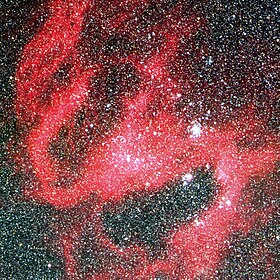R85
 The nebula N119; R85 is the brightest of the small triangle of stars in the lower right "arm". Credit: ESO |
|
| Observation data Epoch J2000 Equinox J2000 |
|
|---|---|
| Constellation | Dorado |
| Right ascension | 05h 17m 56.076s |
| Declination | −69° 16′ 03.77″ |
| Apparent magnitude (V) | 10.84(10.65 - 10.80) |
| Characteristics | |
| Evolutionary stage | LBV |
| Spectral type | B5 Iae |
| Apparent magnitude (U) | 10.28 |
| Apparent magnitude (B) | 10.93 |
| Apparent magnitude (V) | 10.84 |
| Apparent magnitude (R) | 10.53 |
| Apparent magnitude (I) | 10.44 |
| Apparent magnitude (J) | 10.103 |
| Apparent magnitude (H) | 9.980 |
| Apparent magnitude (K) | 9.822 |
| U−B color index | −0.65 |
| B−V color index | +0.09 |
| Variable type | LBV |
| Astrometry | |
| Radial velocity (Rv) | 292 km/s |
| Proper motion (μ) |
RA: -1.0 mas/yr Dec.: -2.3 mas/yr |
| Distance | 160,000 ly (50,000pc) |
| Absolute magnitude (MV) | −8.2 - −8.5 |
| Details | |
| 1960 (minimum) | |
| Radius | 135 R☉ |
| Luminosity | 350,000 L☉ |
| Temperature | 13,500 K |
| 1983 - 1990 (maximum) | |
| Luminosity | 315,000 L☉ |
| Temperature | 10,000 K |
| Other designations | |
| Database references | |
| SIMBAD | data |
R85 (or RMC 85, after the Radcliffe Observatory Magellanic Clouds catalog) is a luminous blue variable located in the LH-41 OB association in the Large Magellanic Cloud.
R85 has been shown to vary erratically in brightness with an amplitude of about 0.3 magnitudes. It shows variations on several timescales, sometimes with a distinct 400 day period. It has also shown temperature changes associated with brightness changes over several years, a characteristic of Luminous Blue Variables.
Based on R85's current properties and evolutionary models, it probably started out with an initial mass of 28 M☉. It is theorized to be making a bubble known as DEM L132a with its stellar wind in the nebula LHA-120 N119, along with S Doradus. It has an infrared excess consistent with a stellar wind contribution.
...
Wikipedia
